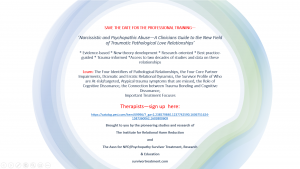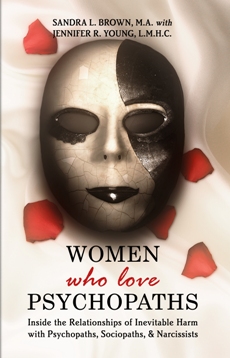What the butterfly knows is transformation and the metaphor they provide is one that survivors can use to see their own transforming recovery.
The beginning of the year is a liminal time and like the butterfly in a cocoon, you are out of one life experience but not yet in another. You are betwixt and between not knowing what the new year will bring. This is a time of possibilities and can be, your time of transformation!
If you can identify with any experience described in The Institute’s newsletters or magazine, then you have been called to the adventure of recovery. This year EMDR can help you release the burden of pain so you can embark on your own recovery.
Survivors are curious ‘what’ EMDR ‘does,’ what is incorporated in a normal EMDR session, and why it claims to be able to help with trauma, intrusive thoughts, and other aftermath effects of Pathological Love Relationships. Let’s see what is involved in EMDR…
EMDR helps you through a process called Desensitization. The call to recovery is usually signaled by the appearance of enormous emotion and can be a mixture of sadness, hope and fascination or it can be grief, fear or anger about betrayal. Most certainly the Pathological Love Relationships has left its mark upon your emotions. How these painful feelings and symptoms get processed is through what is called Desensitization. The technique used in Desensitization is called BLS or Bi-Lateral Stimulation.
The process in Bilateral Stimulation (BLS) is that a therapist uses one or more of the following techniques. They have you
- Follow a light with your eyes
- Follow the therapist’s finger movements with your eyes
- Feel the therapist tapping rhythms on your hands
- Or by listening to auditory tones that the therapist plays on a headset
During these sessions, you are encouraged to let whatever imagery, feelings, sensations or memories rise to the surface without trying to repress them.
When these images, feelings, sensations or memories come up in session, you are asked to focus on three things:
- The image of the incident
- The negative belief that goes with it
- And where you feel these emotions or sensations in your body
Focusing on those three elements coupled with which ever BLS technique that is being used, intensifies the level of response and stimulates the natural tendency of the brain’s information processing system to move toward mental health. In other words, it helps the mind ‘digest’ unprocessed information that was causing emotional (or physical) symptoms. EMDR removes the pain of the trauma that has been blocking your ability to move forward in life (or in Pathological Love Relationships, move forward with releasing the pathological).
At the end of each BLS set, the therapist asks, “What do you get now?” You are encouraged to report any feelings, images or thoughts you are aware of at that point. The therapist encourages you to continue to report whatever comes to you without discarding anything as ‘unimportant’.
Each target memory that is focused on is like the head of an octopus. The tentacles are memory channels containing other related experiences. Sets of BLS are applied to each new awareness or related experience until each channel is cleared out.
If there are new sensations, awarenesses or insights accessed, the therapist will usually say “Go with that” and will go through another BLS set. In this way the clinician encourages further processing of the material until the S.U.D. (Subjective Unit of Disturbance) level is “0” or “1” (on a scale of 0-10 with 10 being the highest level of disturbance). This is continued until there are no new awarenesses.
At the end of each BLS set, the therapist says, “Let it go and take a deep breath.” It is important that you are aware that whatever memories, thoughts or sensations come up during EMDR they are old stuff, it is not happening in the present moment. You are safe in the present
Information processing in EMDR is like getting on a train and watching the scenery of thoughts, images or emotions pass by the train window of your awareness. Each stop of the train is a new plateau of information where dysfunctional material can link up with appropriate, useful and self-enhancing information. Your view isn’t completely functional until the train reaches the “last stop” of fully adaptive information and there are no new awarenesses.
Unburdened and desensitized from the pain of the past, you can emerge from the cocoon with new beliefs and new awareness, empowered to take flight! You will have experienced the transforming power of EMDR!
So, this new year, what will it be ? The pain of the past or the beginning of a new life? The choice is yours. Contact The Institute for more information about our EMDR Retreat in 2011. Space is limited so reserve your healing time now.
For more information on EMDR
- Go to emdr.com, click on “Find an EMDR Clinician,” put in your city and state.
- Read the list and make an appointment with an EMDR trained psychotherapist today or make plans to attend the EMDR Retreat in 2011.






